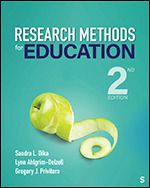Preface
Acknowledgments
About the Authors
Chapter 1: Introduction to Scientific Thinking and the Science of Education
The Scientific Method and Its Relevance in Educational Research
Approaches in Acquiring Knowledge
Generating and Converting Ideas to Hypotheses and Theories
Performing a Literature Review
Testing Your Idea: Confirmation and Disconfirmation
Questions and Activities for Classroom Discussion
Learning Check Answer Key
Review Question Answer Key
Chapter 2: Research Ethics
Ethics in Educational Research
The Need for Ethics Committees in Research: A Historical Synopsis
Ethics in Focus: Classic Examples from Psychology
Human Participant Research: IRBs and the AERA Code of Ethics
Questions and Activities for Class Discussion
Learning Check Answer Key
Review Questions Answer Key
Chapter 3: Scientific Variables, Measurement, and Instrumentation
Defining Variables, Constructs, and Operational Definitions
Classifying Data Collection Instruments
Questionnaire Items and Administration
Concepts in Validity and Reliability of Measurement
Questions and Activities for Class Discussion
Learning Check Answer Key
Review Questions Answer Key
Chapter 4: Sampling From Populations
Why Do Researchers Select Samples?
Subjects, Participants, and Sampling Methods
Methods of Sampling: Nonprobability Sampling
Methods of Sampling: Probability Sampling
Sampling Error and Standard Error of the Mean
Potential Biases in Sampling
Questions and Activities for Class Discussion
Learning Check Answer Key
Review Questions Answer Key
Chapter 5: Choosing a Research Design
Designing a Study to Answer a Question
Categories of Research Design
Internal and External Validity
Demonstrating Cause in an Experiment
Threats to the Internal Validity of a Research Study
Threats to the External Validity of a Research Study
External Validity, Experimentation, and Realism
Questions and Activities for Class Discussion
Learning Check Answer Key
Review Questions Answer Key
Chapter 6: Naturalistic and Existing Data Research Designs
An Overview of Naturalistic Design
The Research Setting: Natural and Contrived Settings
Techniques for Making Unobtrusive Observations
Operationalizing Observations
An Overview of Existing Data Designs
Questions and Activities for Class Discussion
Learning Check Answer Key
Review Questions Answer Key
Chapter 7 : Survey and Correlational Research Designs
An Overview of Survey Designs
Surveys, Sampling, and Nonresponse Bias
Steps in Administering a Survey
The Structure of Correlational Designs
Describing the Relationship Between Variables
Limitations in Interpretation
Correlation, Regression, and Prediction
Questions and Activities for Class Discussion
Learning Check Answer Key
Review Questions Answer Key
Chapter 8: Introduction to Qualitative Research
What Is Qualitative Research?
Distinctions Between Qualitative and Quantitative Research
Three Theoretical Perspectives in Qualitative Research
Steps in Qualitative Research
Role of the Researcher and Entry Into the Field
Sampling in Qualitative Research
Types of Qualitative Data
Questions and Activities for Classroom Discussion
Learning Check Answer Key
Review Questions Answer Key
Chapter 9: Phenomenology, Ethnography, and Grounded Theory Designs
An Overview of Phenomenology Designs
An Overview of Ethnography Designs
An Overview of Netnography and Autoethnography Designs
An Overview of Grounded Theory Designs
Questions and Activities for Classroom Discussion
Learning Check Answer Key
Review Questions Answer Key
Chapter 10: Narrative Inquiry, Case Study, and Critical Theory Designs
Narrative Research Designs
Questions and Activities for Class Discussion
Learning Check Answer Key
Review Question Answer Key
Chapter 11: Quasi-Experimental Designs
Quasi-Experiments and Quasi-Independent Variables
Quasi-Experimental Design: Nonequivalent Control Group Designs
Quasi-Experimental Design: Time-Series Designs
Questions and Activities for Class Discussion
Learning Check Answer Key
Review Questions Answer Key
Chapter 12: Single-Case Experimental Designs
Single-Case Designs: Reversal, Multiple-Baseline, Changing Criterion, Alternate Treatment
Standards for Single-Case Designs
Analysis of Single-Case Designs
Questions and Activities for Class Discussion
Learning Check Answer Key
Review Questions Answer Key
Chapter 13: Group Experimental Designs: Between Subjects, Within Subjects, and Factorial
Conducting Experiments: Between-Subjects Design
Creating Groups and Control of the Independent Variable
Conducting Experiments: Within-Subjects Design
Conducting Experiments: Factorial Experimental Designs
Use of Test Statistics for Group Experimental Designs
Questions and Activities for Class Discussion
Learning Check Answer Key
Review Questions Answer Key
Chapter 14: Mixed Methods Research Designs
Applying a Mixed Methods Design
Types of Mixed Methods Research Designs
Advanced Mixed Methods Designs
Questions and Activities for Class Discussion
Learning Check Answer Key
Review Questions Answer Key
Chapter 15: Action Research
Distinguishing Traditional Research from Action Research
The Process of Conducting Action Research
Questions and Activities for Class Discussion
Learning Check Answer Key
Review Questions Answer Key
Chapter 16: Program Evaluation
The Fundamentals of Program Evaluation
Program Evaluation Standards, Uses, and Limitations
Classifications of Program Evaluation
Models for Program Evaluation
Steps in Program Evaluation
Questions and Activities for Class Discussion
Learning Check Answer Key
Review Questions Answer Key
Chapter 17: Analysis and Interpretation: Exposition of Data
Descriptive Statistics: Why Summarize Data?
Frequency Distributions: Tables and Graphs
Measures of Central Tendency
Graphing Means and Correlations
Using Correlation to Describe Reliability
Standard Scores, z Scores, Percentile Ranks, and Age/Grade Equivalents
Questions and Activities for Class Discussion
Learning Check Answer Key
Review Questions Answer Key
Chapter 18: Analysis and Interpretation: Making Inferences about Data
Inferential Statistics: What Are We Making Inferences About?
Parametric Tests: Applying the Decision Tree
Main Effects and Interactions
Nonparametric Tests: Applying the Decision Tree
Effect Size: How Big Is an Effect in the Population?
Estimation: What Are the Possible Values of a Parameter?
Questions and Activities for Class Discussion
Learning Check Answer Key
Review Questions Answer Key
Chapter 19: Analysis and Interpretation: Making Inferences About Qualitative Data
Qualitative Versus Quantitative Data Analysis
Decisions About How to Record Narrative Data
Decisions About Qualitative Data Analysis and Interpretation
General Process of Qualitative Data Analysis
Interpretations Made Using Different Qualitative Designs in the Data Analysis Process
Criteria of Trustworthiness
Questions and Activities for Class Discussion
Learning Check Answer Key
Review Questions Answer Key
Chapter 20: Communicating Research: Preparing Manuscripts, Posters, and Talks
Elements of Communication
Writing a Manuscript: Writing Style and Language
Elements of an APA-Style Manuscript
Reporting Observations in Qualitative Research
Poster Presentations and Professional Talks
Questions and Activities for Classroom Discussion
Learning Check Answer Key
Review Questions Answer Key
Appendix A: APA-Style Writing, Sample Manuscript, and Posters
Appendix B: Instructions for Randomizing and Counterbalancing
References
Index



